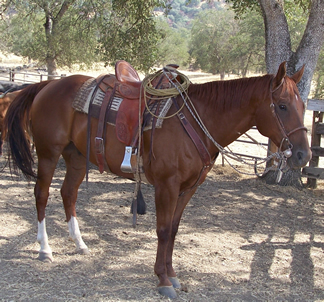 1.) The main purpose of your pad and blanket is to protect the horses back and help distribute the weight and pressure of your saddle. If you have a good saddle fit, the less padding you need and the better off you are. For the type of hard riding we do in rough country, I use a ¾”, 100% wool pad next to the horses skin and a single wool blanket on top. This gives him good protection during the ups and downs of rough terrain but isn’t excessive to the point where it will cause saddle movement. I don’t have to cinch him up overly tight to keep everything in place and he’s comfortable. If I’m riding in less strenuous terrain I’ll simply use my wool double blanket that has a firm weave and is ¾” thick. It’s as close to a good old Navajo as you can get.
1.) The main purpose of your pad and blanket is to protect the horses back and help distribute the weight and pressure of your saddle. If you have a good saddle fit, the less padding you need and the better off you are. For the type of hard riding we do in rough country, I use a ¾”, 100% wool pad next to the horses skin and a single wool blanket on top. This gives him good protection during the ups and downs of rough terrain but isn’t excessive to the point where it will cause saddle movement. I don’t have to cinch him up overly tight to keep everything in place and he’s comfortable. If I’m riding in less strenuous terrain I’ll simply use my wool double blanket that has a firm weave and is ¾” thick. It’s as close to a good old Navajo as you can get.
2.) Keeping your horses back cool is another important factor to consider when you are choosing pads and blankets. Over heating is the common cause of many sore backs. (This is where I come in with my 100% wool sermon!)
3.) Always check for wrinkles. Any little wrinkle can start a sore. A blanket that is too soft next to the skin can start to move and once it travels on the back it can begin to lump up, fold, or crease. If your blanket is moving it can cause friction and friction causes heat. It needs to be of a firm weave, no matter how soft the wool is. The firmer the pad, the better off you are.
4.) We see people using larger blankets today. This is a fad and not necessarily a good one. It may be okay in the show ring where your horse is used for a short period of time but you don’t want to hit the trail with more coverage than you need because, here again, you’re adding heat to the back. A good size blanket will fit one inch in front of your gullet and one inch behind your back skirt. Three to four inches on the sides is ample. The old standard size was 30X30 or 32X32. The blankets I make today are usually 32X34 or 35 but I sometimes have custom orders for 34X36 or 38. While I will honor the customer’s request, I talk with them about this excess. Too much in front of the gullet will ride on the horses neck and too much in the back can rub and sore his rump. Too much on the sides will interfere with the cinch and can eventually cause the blanket to wrinkle and here you go with a problem.
5.) A common fallacy is if you have a mutton withered horse you need more blankets to compensate. The truth is you need actually need less blanket and you need to pull it up good under the gullet to alleviate the pressure on those withers. It is important for all riders to pull those pads and blankets up ¾ “ or more under the gullet to take that pressure off the withers. This is where you so often see the dry spots and the beginning of soreness.
Bottom line…the blankets and pads you choose are of great importance in keeping your horses back healthy and happy. Select the best fiber, wool! Select for firmness and avoid soft, squishy pads. Thickness and softness are not always good. Select blankets you can wash and ones that retain their shape. Try to keep a few extra blankets around. Remember, you can’t always remedy a poor saddle fit but you can improve on the fit by adding or subtracting blankets. Another helpful and valuable hint when it comes to keeping old pads around: If you’re on a pack trip and sore a horse or mule, you can take and old pad and cut out a hole to fit over the sore spot. Put you other blanket on top of that and it will keep the pressure off the sore spot until you can get home.
Happy trails,
Linda